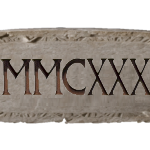Hostoricl meaning for Roman Numerals 1 to 900
Roman numerals are a numeral system that was used in ancient Rome and is still occasionally used today for various purposes, such as in the names of monarchs, popes, and for numbering the chapters or sections of books and movies. Here are the Roman numerals from 1 to 900 along with some historical contexts for each:
- I – The Roman numeral for 1. It represents the number one in the Roman numeral system.
- II – The Roman numeral for 2. It represents the number two.
- III – The Roman numeral for 3. It represents the number three.
- IV – The Roman numeral for 4. The numeral IV is often associated with the Latin word “quattuor,” meaning four. It’s worth noting that the Romans sometimes wrote 4 as “IIII” on clock faces and inscriptions, though “IV” is more common.
- V – The Roman numeral for 5. It represents the number five.
- VI – The Roman numeral for 6. It represents the number six.
- VII – The Roman numeral for 7. It represents the number seven.
- VIII – The Roman numeral for 8. It represents the number eight.
- IX – The Roman numeral for 9. It represents the number nine.
- X – The Roman numeral for 10. It represents the number ten.
- L – The Roman numeral for 50. It represents the number fifty.
- C – The Roman numeral for 100. It represents the number one hundred.
- D – The Roman numeral for 500. It represents the number five hundred.
- CM – This is a way to represent 900 in Roman numerals. The “C” represents 100, and the “M” represents 1,000. When “C” is placed before “M,” it represents 1,000 – 100 = 900.
These Roman numerals were used in various historical contexts in ancient Rome, such as for numbering years, dates on inscriptions, and in counting and calculations. They continue to be used today in certain formal and symbolic applications
Roman Numerals Chart 1-100
Roman numerals from 1 to 100, which should help you understand the pattern and principles of Roman numerals. You can then continue the pattern up to 900 using the same principles. Here’s a Roman numeral chart for 1 to 100:
1 – I 2 – II 3 – III 4 – IV 5 – V 6 – VI 7 – VII 8 – VIII 9 – IX 10 – X 20 – XX 30 – XXX 40 – XL 50 – L 60 – LX 70 – LXX 80 – LXXX 90 – XC 100 – CRoman numerals follow a repeating pattern based on powers of 10. To continue this pattern up to 900, you can use the following:
- 200: CC
- 300: CCC
- 400: CD
- 500: D
- 600: DC
- 700: DCC
- 800: DCCC
- 900: CM
So, now you have a Roman numeral chart from 1 to 900:
1 – I 2 – II 3 – III 4 – IV 5 – V 6 – VI 7 – VII 8 – VIII 9 – IX 10 – X 20 – XX 30 – XXX 40 – XL 50 – L 60 – LX 70 – LXX 80 – LXXX 90 – XC 100 – C 200 – CC 300 – CCC 400 – CD 500 – D 600 – DC 700 – DCC 800 – DCCC 900 – CMYou can continue this pattern for numbers beyond 900 as well by adding more “C”s and “M”s, following the same principles.
Roman Numerals Quiz
Question 1: What is the Roman numeral for 10?
Question 2: What is the Roman numeral for 5?
Question 3: What is the Roman numeral for 1?
Question 4: What is the Roman numeral for 50?
Question 5: What is the Roman numeral for 100?

